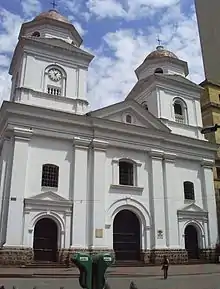Basilica of Our Lady of Candelaria
The Basilica of Our Lady of Candelaria or simply La Candelaria Church, as it is more popularly known, is a Roman Catholic temple dedicated to the Virgin Mary under the title of Virgin of Candelaria. It is located in the center of the city of Medellín, Colombia, on the eastern side of Berrío Park.[1] It is famous for being the oldest church in the city.
| Basilica of Our Lady of Candelaria | |
|---|---|
 Front entrance | |
| Religion | |
| Affiliation | Roman Catholic Church |
| Location | |
| Location | 50th and 51st street, La Candelaria, Medellín, Colombia |
| Architecture | |
| Type | Church |
| Style | Neoclassical |
It was the church of the Archdiocese of Medellín from 1868 to 1931, when this title passed to the Cathedral Basilica of the Immaculate Conception.[2] It is a colonial building with a Neoclassical style. Its original structure built in stone and mortar has been "patched" over throughout its history with foreign substances.
On December 8, 1970, Pope Paul VI granted it the title of Minor basilica.[3] Renovations occurred during 1997 and on July 31, 1998, by resolution 0795, the building was declared a National Monument of Colombia.
History
In 1616, the colonial visitor Francisco de Herrera y Campuzano founded a settlement with 80 Amerindians, naming it "Poblado de San Lorenzo," today "El Poblado Square". In 1646 a colonial law ordered the separation of Amerindians from mestizos and mulattos, so the colonial administration began the construction of a new town in Aná, today Berrío Park, where the church of Nuestra Señora de la Candelaria de Aná ("Our Lady of Candelaria of Aná") was built. Three years later, the Spaniards started the construction of the Basilica of Our Lady of Candelaria, which was rebuilt at the end of the 18th century.[4] It was dedicated to Our Lady of Candelaria, an invocation of special devotion to the Spanish and particularly for the sailors who crossed the Atlantic to the New World.
Interior

The main altar is made of gold-painted wood. A painting of the Virgin of Candelaria, the town's patron saint, is displayed above the altar.[5]
See also
References
| Wikimedia Commons has media related to Basílica Menor de Nuestra Señora de la Candelaria. |
- Christopher P. Baker (2012). National Geographic Traveler: Colombia. National Geographic Society. pp. 169–. ISBN 978-1-4262-0950-5.
- Rough Guides (1 August 2011). The Rough Guide to South America On A Budget. Rough Guides. pp. 583–. ISBN 978-1-84836-774-6.
- GCatholic.org. "Basilicas - Colombia".
- Restrepo Uribe, Jorge (1981), Medellín, su Origen, Progreso y Desarrollo, Servigráficas, Medellín. ISBN 84-300-3286-X.
- Krzysztof Dydyński (1988). Colombia: A Travel Survival Kit. Lonely Planet Publications.